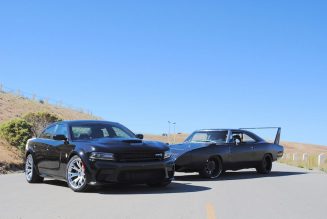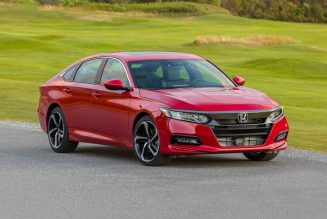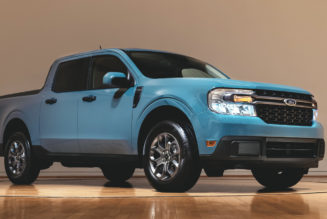Chevrolet Corvette Full Overview
Frustrating, right? Everyone loves a winner, no one aspires to be a loser, but one cannot exist without the other. On the subject of horsepower and performance, there’s a more powerful car, a faster car, and a slower car, and there’s only one choice—otherwise, why bother harvesting test data to begin with?
The Eternal Corvette vs. Porsche Face-Off
These inevitable Porsche versus Corvette stand-offs usually raise subjectivism versus objectivism in our minds like bile in our throats. After all, the Corvette—in all its modern permutations—is the de facto victor on the performance-per-dollar front; it shouldn’t lose, at least not on paper. Forget the C8; a 16-year-old base C6 Corvette from 2005 is both lighter and more powerful than today’s base 992-series 911 Carrera. Our choice was easier back then, too: Pick the lairy V-8 fiberglass wedge for atomic straight-line blasts and ass-out antics, and the finespun, finesse-inspiring Porsche for absolute confidence and driving sublimity.
But that was long before General Motors engineered the C8 Corvette Stingray, one of the finest and most impressive performance cars available. As we enumerated in our prior face-off between the new C8 and the 992 Carrera—in which the Corvette claimed the honors—the mid-engine Corvette isn’t just good for an American automaker, it’s a world-class supercar. Galaxy-class, even.
Sports Car vs. Sports Car? Not Quite
This test is not sports car versus sports car, it’s supercar versus sports car.
Quit shaking your head. If you consider the McLaren 570S, Acura NSX, and Audi R8 V10 to be supercars, the title must also go to our long-term C8 Stingray Z51. The car matches or beats each one of them in our skidpad and figure-eight tests, and it’s only a couple of tenths slower from 0 to 60 mph, aside from the absurdly quick Audi. If you desire the low-slung visual panache of a supercar, the C8 is all that and more. In fact, we reckon the Corvette’s stratospheric production figures will go a long way in normalizing the mid-engine shape. The front-engine Ferrari 812 Superfast—often derided for its C7 Corvette proportions—is now an alien novelty once again.
Conversely, the Porsche 718 Cayman GTS 4.0—quite an alphanumeric mouthful—is the purest expression of what it means to be a mid-engine sports car in 2021. You might wonder why, after the C8 finished ahead of the 992 Carrera, we brought a slower, less capable Cayman to the fight. It’s simple: The 718 GTS 4.0 twins (Cayman and Boxster) are, by and large, more special machines than the base 911.
A Welcome Throwback
The GTS 4.0 is like a Porsche from a lost era and not something we expected to see resurge. As goes the 911, so goes the Boxster/Cayman; when the majority of the 911 family went turbocharged for the 991.2 generation, the 718s came a year later in 2016 with turbocharged flat-fours across the board, including the eventual 718 GTS. Between 2017 and 2019, if you wanted a naturally aspirated Porsche sports car, you had to save for a 911 GT3 or surf the used market.
Then the next-gen Cayman GT4 and Boxster Spyder arrived with a 4.0-liter naturally aspirated flat-six, barbecuing the pleasure centers of our brains into Texas brisket. Stuttgart next crammed the engine into the latest 718 GTS, and turned brisket into foie gras. It remains one of the automotive industry’s most stunning and welcome philosophical reversals during the past decade.
Like Porsche GTS varietals to come before and all to come in the foreseeable future, the 718 GTS is, by design, the family sweet spot. Building the 718 GTS starts with standardizing all of the optional go-fast hardware available on lesser Caymans and Boxsters, and turns the wick up a few percentiles to give the platform an edge over a maxed-out 718 S or T. Brakes are bigger, the suspension is stiffer, driving aids are sharper, seats are tighter, exterior trim is darkened, and interior surfaces are usually draped in Alcantara.
Jumping from the 718 S to the GTS is now less about handy order-sheet packaging and instead all about the engine. The GT4’s/Spyder’s 414 hp is now 394 hp in the GTS 4.0, though torque remains a stout 309 lb-ft when equipped with the six-speed manual transmission, or 317 lb-ft with the seven-speed dual-clutch PDK gearbox like the one in our Guards Red tester.
Special Car, Not So Special Engine
For all our prior poetic waxing about the Corvette’s exotic qualities, its mid-mounted 6.2-liter LT2 V-8 and its 495 hp are borderline prosaic. The new-ish LT V-8 family that made its debut in the C7 Stingray back in 2014 is a direct continuation of the LS engine bloodline that in some form has sublimated rear tires and set off car alarms since 1997. Aside from an extra 40 hp and some reworked hardware for its placement within the car, it spins up, roars, pulls, and shakes like every other LT1 we’ve ripped in the sixth-gen Camaro SS and C7 Stingray.
The most interesting bit of the Chevy’s powertrain is the Tremec M1L eight-speed dual-clutch transmission, a first for Corvette. Gone is the C7’s quick-shifting 10-speed automatic, as is the seven-speed manual. According to Corvette engineers, they left the stick on the shelf as a result of both packaging concerns and the manual’s low take rate by C7 customers toward the end of the car’s production run. Conversely, the 718 GTS 4.0 launched exclusively with a six-speed manual, only adding PDK to the order form earlier this year.
Corvette vs. Porsche Kick-Off
We began this comparo in the saddle-brown-leather-lined embrace of our long-term Corvette, handing off the Porsche to senior features editor Jonny Lieberman for a lead-follow shakedown blast up Southern California’s inimitable Angeles Crest Highway.
ACH’s long, wide, straight sections have the uncanny ability to snuff sensations of speed, and the Stingray’s creamy torque curve and relatively wide footprint dampened it further. It’s all an illusion, of course; our C8 is, in reality, a tremendously quick car. The dual-clutch drops the MotorTrend-tested 0-60-mph scramble to a wild 3.1 seconds, and the car rushes on through the quarter mile in 11.4 seconds, enough to spook out-of-season Ferraris and retired Lamborghinis from light to light.
Despite this serious scoot, power delivery is linear and progressive, a world away from the squiggly bazooka-blast hole shots fired off by older Z06s and ZR1s. Actually, most of the C8’s inputs are surprisingly soft; everything loads up beautifully, but there’s a nagging sensation that if you were to deconstruct the front end, you’d find the Z51 package’s magnetorheological dampers encased in bubble wrap and the steering motor filled with frozen custard.
Considering new C8 Z06 and ZR1 variants are approaching at terminal velocity, this pseudo-cushiness is by design. Don’t confuse relative softness for dullness: The Corvette is implacable in tricky, off-camber fast corners with shocking front-end grip and a glued rear end that seems indifferent to any overaggressive throttle jabs. “The steering is great,” Lieberman said after a stint behind the wheel. “Super communicative, no understeer, no complaints from me. The rear end manages traction so well. Such a massive improvement over the C7.”
The Porsche Gets Skittish
Unlike the Porsche, the Chevrolet is a car purpose-built for fast sweepers. In a shocking role reversal, the big, meaty Corvette makes the ever-confident Cayman feel relatively nervous and on edge in comparison. All right, that might be a bit of an exaggeration to make the point, but there’s an undeniable urgency to the GTS’ movements not present in the Corvette’s deliberate pace.
The Cayman is more darty, but the familiar Porsche confidence is baked in, four layers thick. Some cars take a few miles to get accustomed to; others require a few hours, even days before everything feels natural. Never driven a Porsche in your life? It will take just a handful of seconds for the 718 GTS’ driver’s seat to feel as familiar as your TV room recliner. The car’s steering inputs are as welcome as lifting your morning coffee mug, the brake pedal like shuffling around in your bath slippers.
Everything—every single control—is weighted perfectly and tuned for tactility. The steel brakes bite hard and inspire enormous confidence, allowing for brake-anywhere corner approaches that inspire you to explore just how tacky the rear end is. The Cayman shares the C8’s flypaper front end, along with the Corvette’s spooky traction when you nail the throttle pedal. No drama, no squiggle, only a direct pipeline of smooth, unbroken acceleration.
“There’s an elegance to the way the GTS changes directions that’s missing from modern sports cars,” Lieberman said. “There are definitely cars that change direction as well, but there’s an oiled, buttered elegance at play here that’s borderline automotive magic.” The Cayman flows through snaked tarmac like hot honey on Teflon; if the Corvette is an Olympic gymnast, the Cayman is the figure skater.
There’s Nothing Like That 4.0
And that sound. The Cayman’s 4.0 spins up like a circular saw to its 7,800-rpm redline, and it emits a metallic zing and mechanical thrash that sounds like the same buzz saw slicing through a bundle of titanium organ pipes. Power is predictably peaky, with access to all 394 stallions locked behind the 7,000-rpm mark, and max torque peters off after 5,000 rpm. This lofty powerband is wrangled handily by Porsche’s uber-trick PDK that slings the GTS 4.0 from 0 to 60 mph in a stellar 3.4 seconds and down the quarter mile in 11.8 seconds, just 0.3 and 0.4 second off the C8’s respective times.
With 432 fewer pounds to move compared to the Stingray, the featherweight(ish) Cayman greases its way through the figure eight at 23.6 seconds at an average of 0.85 g, just tailing the ‘Vette by 0.2 second and 0.01 g. The Porsche beats the C8’s wide, flat butt with a 1.03-g performance on the skidpad and a 98-foot 60-0-mph stop, bettering the American by 0.02 g and a measly 1 foot, respectively.
Grandly Grand Touring
Peanut butter and chocolate in the canyons, but chalk and cheese in day-to-day operation. After we bid auf wiedersehen—or a big ol’ “See ya!” in Corvette-speak—to Lieberman, we pointed the Corvette toward Ojai’s incredible State Route 33 to suss out more of the C8’s merits. The roughly 2.5-hour drive turned the new Corvette from impressive to spectacular: Equipped with the Z51 Performance package’s aforementioned MagneRide suspension, the C8 Stingray is one of the best mid-engine grand tourers, ever.
The physical seat-to-ass contrast of ripping through ACH and Route 33 at escape velocity and the way the C8 floats over expansion joints and road divots is extraordinary. It convinces you it’s as comfortable as any modern Buick, and it boasts interior fit, finish, and design that would do the Cadillac crest proud. Actually, it would do most marques proud.
“I stand by my belief that if you removed the interior badges, sat a blindfolded person in the C8, then removed the headscarf and told them this is the new Ferrari or Lamborghini, they’d believe you,” Lieberman effused. The C7 Corvette’s cockpit was hardly a prairie outhouse, but the C8’s unbelievably tight interior details are a step above even some of the plastic-fantastic trim found on Lamborghinis. Like we said—a galaxy-class car.
The Cayman’s 1.5-hour jaunt to one of our favorite technical roads in the Los Angeles area was significantly less coddling. The seats and driving position are near faultless, but the flinty ride and buzzy highway drone fatigued us early. Fit was typical Porsche perfection, but the 718’s interior bones are going on eight years old in 2021, and the extensive use of plastic trim is beginning to show its age, if only slightly.
Choosing Is Almost Impossible
Considering our test Cayman cracked the savings account at $94,200, little stuff like that matters. The Corvette’s $80,420 tag is easier to swallow, especially considering just how much car—inside and out—you get for the money; 80 big ones ain’t cheap, but a stripper $60,000 C8 Stingray returns 90 percent of our semi-loaded example’s offerings for substantially less coin.
Now we arrive at Sophie’s choice. If we could, we’d declare a tie and tell you to simply pick what stirs your soul—but we can’t. So we consider the idea of strategic versus tactical victories. A strategic victory involves a win of long-term consequences and disrupts the enemy’s ability to continue to wage war; that fits the extraordinary 2020 Chevrolet Corvette Stingray nicely. If this is what a base Corvette drives, looks, feels, and sounds like, the forthcoming Grand Sport, Z06, and ZR1 permutations will irreversibly disrupt the supercar landscape. What a car, and what a future we have to look forward to.
A tactical victory emerges from the completion of a specific objective or offensive. If this comparison is the operation in question, it goes to the 2021 Porsche 718 Cayman GTS 4.0. In a contest of which car feels better to drive, it’s the Porsche every time. The Corvette’s ability to crush a mountain pass and then fade effortlessly into the background on the drive home is peerless; it’s a heady blend of point-to-point mundanity and real-deal supercar status, but the Porsche never, ever feels anything less than special.
There are two (three, if you want to look at it that way) mid-engine cars available with a manual transmission in 2021: the 718 and the Lotus Evora GT. Only one of them offers both a naturally aspirated engine and a manual transmission. It’s a jewel of a sports car, and one we’re not sure will be with us for the long haul as Porsche shifts toward an electric-focused future. Presented with a trailer containing both the Cayman and the Corvette, and under the stipulation we can only keep one, the 718 Cayman GTS 4.0 is the car that rolls down the ramp.
2nd Place: 2021 Chevrolet Corvette Stingray Z51
- One of the best all-around supercars we’ve ever driven
- Superb power delivery
- Ultra-progressive handling
- Supremely comfortable in lesser modes
- Soft-ish controls give illusion of soft handling
- Can feel a bit large on tight roads
- Limits can (should) only be reached on a track
1st Place: 2021 Porsche 718 Cayman GTS 4.0
- Engine configuration we thought dead outside of a GT3
- Unbelievable sound
- Absolute confidence on the move
- Makes every road feel special
- Stiff, flinty ride
- Plasticky interior is getting a smidge dated
- Sky-high price tag








